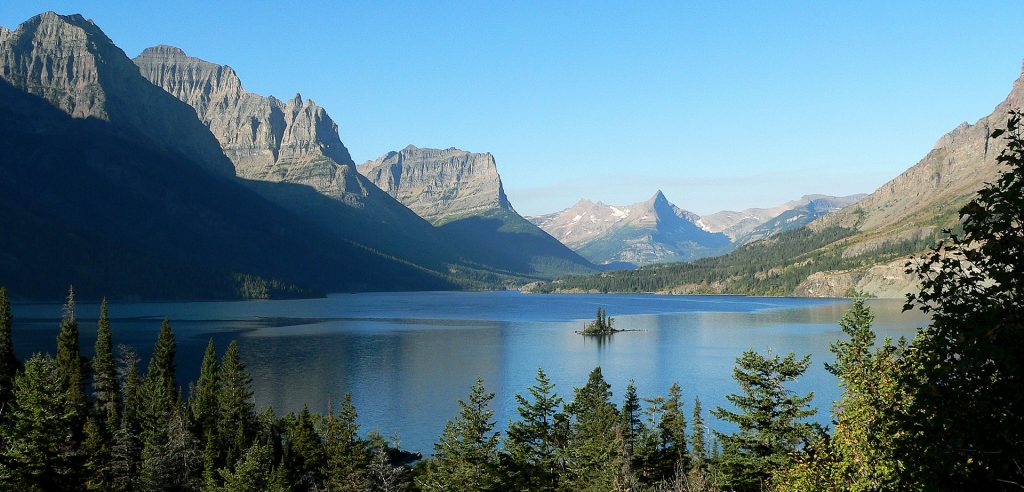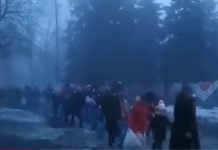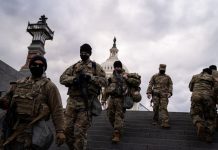
The four-bedroom contemporary just west of town smelled of fresh paint, flooring, sealant and new beginnings. The Bridger Mountains beckoned against an azure sky off the back deck, and Robert Carder, Montana’s newest transplant, couldn’t contain himself.
“This is your new home, Conner!” he exclaimed to his 57-pound Australian cattle dog, whose paws were slipping on the wood floor in the living room. Carder spread his arms wide. “How much bigger is this than the picture?” he asked his wife, Valentina, confirming what the couple from Los Angeles already knew.
Their living room didn’t just seem bigger than the photos on Zillow that had led them to make a $559,000 offer after 24 hours in Montana, a place they had never been. The 2,300-square-foot house was twice the size of the two-bedroom condo they sold in Brentwood, Calif., before packing their cars and driving 16 hours northeast, released from the confines of the coronavirus pandemic and the jobs Robert had grown to hate and Valentina had lost.
This was the 19th walk-through their broker, Charlotte Durham, had done for out-of-state clients since Montana’s virus lockdown ended in late April and its real estate market flipped into hyperdrive. Buyers fleeing New York, Los Angeles and other densely populated U.S. cities say they want to leave the coronavirus clusters and social justice unrest behind.
Even as the state’s fierce winter looms, the transplants are pushing house prices to record levels. Some are offering millions of dollars in cash for houses and land they have seen only on the Internet.
“They were like, ‘We’re hoping we love it!’ ” Durham recalled on a late-summer morning as the Carders nodded in agreement.
Montana has remained a mystery to most Americans, even though it boasts some of the most magnificent scenery in the West.
But as the pandemic has taken hold across the United States, what once were rural outposts here have turned into boomtowns.
These arrivals are not just tourists visiting Yellowstone National Park or looking for a wilderness vacation. This is a stampede of transplants descending in Porsche Cayennes and Teslas with cash offers. It’s multimillionaires grabbing up luxury ranches to serve as second or third homes. It’s buyers with more modest resources looking for a way out. It’s city dwellers seeking bare land in Montana’s wilderness to serve as insurance policies for America’s uncertain future.
But the virus they are fleeing has been spiking here, too. Along with the neighboring Dakotas, the state has one of the worst per capita outbreaks in the country. Montana’s coronavirus infections have risen precipitously in recent weeks, with a seven-day rolling average of 58 new reported cases per 100,000 residents, the third-highest rate in the United States. The total number of confirmed cases and deaths remains low – less than 24,000 cases and 241 deaths – but nearly 3,800 of those cases and 10% of the deaths were reported in the past week.
“We still have way fewer cases than most places and lots of wide open space,” said Durham, 31. “It’s way better here than where people are coming from.“
The new infections have overwhelmed jails and health-care clinics in some communities and led to suspicions that outsiders are bringing the virus with them. But Democratic Gov. Steve Bullock and health authorities said last week that out-of-state visitors account for fewer than 5% of Montana’s new cases.
“This is coming from us, to us,” said Sarah Stewart, a family physician at St. Vincent’s hospital in Billings, which serves the city and the Eastern Montana region.
Sportsmen have long revered Montana, casting flies for the world-class trout in its rivers and hunting deer and elk on its snow-capped mountain passes. A century ago, the state’s mines and forests provided jobs to immigrants from Northern Europe. In the 1990s, moviegoers glimpsed its sun-dappled rivers and towering firs in Robert Redford’s adaptation of the Norman Maclean memoir “A River Runs Through It,” and a generation of retirees and environmentalists put down roots to smell the sagebrush for themselves.
Silicon Valley tech workers put southwest Montana on the map a few years ago, as they sought an alternative to ever-pricier towns like Aspen and Vail in Colorado and the Jackson Hole region in Wyoming. They’re taking advantage of the wide open spaces at Big Sky, a ski resort in the midst of a building boom 40 miles south of Bozeman. The transplants work remotely and commute from a growing airport with more hangars for private jets than commercial carriers.
Downtown Bozeman remade itself with craft breweries, gluten-free bakeries and high-end galleries displaying frontier art. Soon a derisive nickname followed: Bozeangeles.
The newest migrants are different. They’re escaping fear, of the pandemic and of the social justice marches they believe are bringing violence to their door. Montana can bring them back in time.
The state is open for business. Interest rates are hovering below 3%. The mask police lay low. In a hyper-divided country, Montana’s politics are balanced. Its demographics less so, but that is part of the appeal for many who are coming here.
“We are 98 percent Caucasian,” said Candace Carr Strauss, chief executive officer of the Big Sky Chamber of Commerce. “We haven’t, thankfully, seen a lot of the unrest other places have seen.”
The once-sleepy Big Sky ski resort is quickly acquiring first-tier status. Its private mountain ski club for the ultrarich no longer has an offseason, what with so many members who sought refuge from the pandemic in March and never left. The mountain plans to open its slopes on Nov. 26 – with new coronavirus protocols in place.
housing market gold rush
The property gold rush of 2020 has been dizzying. Deals move too fast for a review of comparable sales. Appraisers and title companies are being outpaced by the demand. Lenders are confronting liquidity problems. And developers can’t keep up with the thirst for new homes, which are preselling as soon as floor plans come to market.
“We’re running around like lunatics,” said Amy Hyde, a mortgage broker in Bozeman. “People have done a month in an RV, and they’re saying they want to move to Montana. The number of out-of-state cars in our town right now is insane.“
Her loan volume has tripled since the spring. When she did not return a buyer’s call for 20 minutes a few weeks ago, the buyer had already found another lender, she said. “People are just frantic and so stressed out.“
The median price of a single-family home around Bozeman vaulted $94,000 from July to August, to $710,000, according to the Gallatin Association of Realtors, which tracks sales in the city of 52,000 and surrounding valley, the state’s fastest-growing region.
Montana’s less-flashy population centers, from the old railroad hub of Billings to the college town of Missoula, also are seeing buying frenzies. Even the long-depressed mining town of Butte and the isolated state capital, Helena – with a main street called Last Chance Gulch and a legislature that meets every other year – have watched prices surge 22% to 25% above pre-pandemic levels.
“There’s a perception that a lot of things are going to change depending on the election outcome, and here you can protect yourself where you still have gun rights,” said Myrna Rue, a real estate agent in Red Lodge, an old coal-mining town of 2,300 at the edge of the Beartooth Mountains. During one week in mid-August, she was juggling 39 deals.
Social changes
The state is changing so fast that even those who study rural migration patterns have no idea how long the madness will last – or how many people are even coming. This summer, Bozeman Yellowstone International Airport added five flights a day.
What’s far clearer is that the infusion of wealth is creating tension; Bozeman is now a city of haves and have-nots, and it is breeding resentment.
“It’s changing the whole basis of the state,” said Mike Garcia, owner of Northern Lights Trading Co. – River, Lakes and Oceans, an outdoor sports and recreation store. And it’s not for the better, he said. The summer brought its usual share of inexperienced sportsmen, he said, but in larger numbers. “My wife would call me up and go, ‘You need to come talk to these people. They’re clueless.’ “
The city’s rental market has almost entirely evaporated, devoured by an Airbnb market fetching hundreds of dollars a night.
“Help Wanted” signs hang in windows along Main Street, which is desperate for employees to serve food and drinks, and sell cars and hiking boots – if they can afford to live here. Off-campus housing has dried up at Montana State University, where 16,700 students returned in August to in-person classes.
The Bozeman City Commission approved a $740,000 grant this month for a fund to coax developers to build affordable housing. The city, worried about its water supply, has imposed a surcharge on homeowners who use too much. It’s asking developers to adorn their subdivisions with fewer plants. The new city manager is devising a plan to allow more density on less land, a smart-growth approach traditionally used by cities trying to preserve open space but an unusual strategy in a place that has long prided itself on having so much of it.
Terry Cunningham, a city commissioner who moved here from New York City 21 years ago, compared Bozeman to Boulder, Colo., which imposed strict building limits long ago.
“They’ve said they won’t grow,” he said. “Our issue is how to accommodate growth in a manner that’s equitable.“
Durham sold $30 million in real estate from June through September. It is a huge boost for business, but a change she laments, too, as she reflects on her lineage as a fifth-generation Montanan from ranching and construction stock.
“In a way, it’s sad to see things selling at such a huge price point,” she said.
She pulled her black Range Rover from the curb of the Carders’ new house, her long platinum hair pulled behind the Bluetooth in her right ear. It was 78 degrees.
“I’ll be really curious to see what all of these buyers think of our winters,” she said.
Durham calls herself a “girly-girl who grew up hunting and fishing,” part rugged Montanan in her brown suede cowboy boots and feather earrings, part the urban sophisticate her clients are looking for, in a white linen pantsuit, makeup and red nail polish.
Her work ethic and marketing skills as a solo boutique broker convinced Sotheby’s to recruit her as an owner-broker in May, as the state was still reopening after its lockdown. The deals have not let up, even with the recent coronavirus surge.
When Robert Carder emailed from Los Angeles in July, Durham said a home in their price range, about $550,000, would be a hot commodity. She discovered The Lakes at Valley West, a subdivision of postage stamp lots on disappearing ranchland. Some houses are wrapped in Home Guard, awaiting completion.
The couple are neither hunters nor anglers. Valentina, 34, born and raised in Russia, said she “loves, loves, LOVES L.A.” But when Santa Monica shut down as the virus ravaged Southern California, she lost her job as an aesthetician. Robert, a consultant who managed a bar and restaurant at night, had always said he would never leave California. But he had grown weary of “making cocktails in jars like it was a conveyor belt” to hand to customers through a takeout window, he said.
In Bozeman, they sense opportunity. “We think she’ll be a superstar in town,” Robert, 52, said of the salon his wife plans to open this week.
Durham’s next clients sensed opportunity, too, and were putting their Nordic-style home on 58 acres outside of town on the market. She parked next to the three-car garage with a Jaguar inside and climbed a handcrafted northern fir staircase to the main level. David Rafes and his wife, Meg, plan to relocate to Hawaii, and today was staging day.
Rafes, 71, made his money in Dallas selling car turbochargers. “I hate to say this,” he said, gazing at the sweeping views of the Gallatin Valley from his cedar deck, “but I’m taking advantage of the problems in the country with the covid thing.“
The stager arrived, excited for the photographic possibilities provided by the 23-foot ceilings and doors made of Alder wood. The home listed at $3.5 million.
It was onto the next appointment. Durham’s phone rang. It was a buyer named Brian from Corona del Mar in Orange County, Calif., inquiring about Holland Lake Lodge, a rustic lakeside resort near Missoula she has listed for $3.5 million.
“Give me the 30-second pitch!” Brian said. “It seems too good to be true.“
Durham described a remote retreat with Montana charm, six guest cabins and a “truly magical waterfall.” The only hitch was that under a Forest Service agreement, the property has to remain open to the public in some capacity.
“I get three calls like that a day,” Durham said. “Everyone is just looking for what’s next, I guess.“
She checked in with a retired business owner from Indiana who had cold-called a few weeks earlier after watching the opening episodes of “Yellowstone,” the Paramount series starring Kevin Costner about a sixth-generation Montana rancher trying to save his land.
The man has never been to Montana, but the swashbuckling image of Costner on a horse, wearing a Stetson and corralling his cattle, mesmerized him. Plus, there’s politics. “If Joe Biden wins, I’m getting out of the Midwest,” he told Durham.
He planned to fly out before the snow came.
Durham’s assistant, Meredith Curtin, texted: They had six closings scheduled for the next week. “We really have to go through what their gifts are!!” Curtin wrote. In this market, closing gifts are touches that matter.
Not everyone coming here is buying. Durham found a coveted rental for Jennifer Stoker and her husband, Chad, who arrived in September to start a food delivery business for owners in the private Yellowstone Club at Big Sky.
When protesters marched in Chicago this summer, the couple was living in a two-bedroom apartment on Lake Shore Drive. They saw businesses looted and heard gunshots as they drove home. It scared them.
“Chicago was a great city,” said Jennifer, who worked as private chef for a Yellowstone Club owner who lives outside Chicago. “But the state of it now makes me feel differently. I just don’t feel safe.” Her husband gave up his job as a golf course manager to help run the new food business. He had never been to Montana.
“We need a less stressful life,” Jennifer said. “And it’s pristine and breathtaking.“
Friday afternoon had arrived, and Durham swung her car into the Sotheby’s parking lot. She opened her laptop for status checks before the weekend. She was waiting on an electronic signature from a buyer who was closing on an estate listed for $10.9 million after just one visit to Montana.
“It seems crazy that someone could DocuSign for a purchase this big, right?” said Curtin, as she and Durham went over their to-do list at the office.
The inspection on another property had turned up a leak in the hot tub. There was an open house for brokers the following week. They would need to order a charcuterie board from Fink’s.
Finally, there were the gifts. It was an easy call. A bottle of Brut and a $500 gift certificate for each buyer to the Sage Lodge, a resort in the Paradise Valley on the route to Yellowstone. Curtin added them to her list.
I don’t know if anybody living there for a long time is liking this market situation… This is insane, no? More on Chron, Strange Sounds and Steve Quayle.













National Guard taps units for rapid response to civil unrest
By LOLITA C. BALDOROctober 2, 2020 GMT
WASHINGTON (AP) — The National Guard has designated military police units in two states to serve as rapid reaction forces so they can respond quickly to any potential civil unrest around the country, following violent protests that rocked the nation’s capital and several states this summer and after election?
Military leaders don’t explicitly tie the changes to concerns about possible election-related violence, but the nation is bracing for unrest surrounding the tumultuous presidential campaign, particularly if voting results are not known for days or weeks because of the increase in mail-in ballots.
According to the Guard, about 600 troops — 300 in both Alabama and Arizona — will be ready to deploy within 24 hours if requested by a governor in another state. And Guard leaders have also bought more than $200,000 in new protective equipment, and have increased troop training on proper procedures in dealing with protests.
The moves come as Defense Department and National Guard leaders work to address shortfalls that were identified in the military response to the June protests triggered by the death of George Floyd in Minneapolis. Military reviews of the response to the protests found problems with coordination between various state and federal government and law enforcement agencies — which at times slowed down troop movements.
“Coordination and communication were the probably the things that we’ll look back on and see very challenging,” Army Secretary Ryan McCarthy said in an interview with The Associated Press. He said that as the protests escalated in D.C., and the call for help went out to governors around the country, 11 states said they were willing to provide support.
“But the problem with that is how quickly can you marshal them together, ensure they have the appropriate training, ensure they have the appropriate equipment, understand the task you’re going to give them?” said McCarthy. “It’s American streets. It could turn violent. It was an incredibly challenging thing.”
Governors can use National Guard troops for a variety of things, ranging from natural disasters such as hurricanes and wildfires, to assisting with border security and civil unrest. If a governor needs additional help, they can request troops from other state governors through a compact agreement system that details how the forces will be used and what they can and cannot do.
Lt. Gen. Mark Sasseville, vice chief of the National Guard Bureau, said the Guard employs a graduated approach, with states using their own troops first, and then, if more help is needed, they request forces from other states within their region. If more support is needed, then governors reach out to states further away.
“That makes sense because typically the states have good relations with the neighboring states,” said Sasseville in an interview with The Associated Press. “Speed becomes an element of this discussion.”
The problem, however, is that some states couldn’t free up troops to send to others because they also were dealing with protests or other emergencies. The Guard’s decision to formally designate troops in Alabama and Arizona as quick reaction forces will help because those units have aircraft that will allow them to rapidly deploy to another state within 24 hours of a governor’s request.
Guard officials said the forces in Alabama would respond in the eastern half of the country, and those in Arizona would respond in the west, and their deployment window at this point extends through the end of this year.
“A big thing that we’ve done differently is being able to move faster,” said Sasseville, adding that the Guard also had to buy equipment to replace protective gear for some units.
Military police from the Arizona National Guard were mobilized at least twice this year in support of law enforcement, including to Wisconsin and in response to protests in Phoenix in the wake of Floyd’s death.